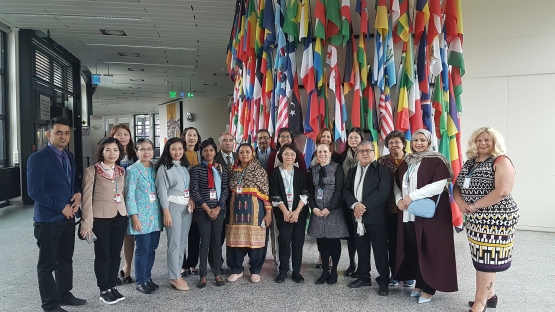A new four year project to help countries in the Asia and the Pacific region to use stable isotopes to understand the growth, body composition and energy requirements of infants and young children aged 6 to 24 months has kicked off in Vienna. The project[1] involves 17 countries, and is the largest IAEA nutrition project undertaken in the region so far. The goal of the project is to enable stakeholders to understand the double burden of malnutrition in the Asia and the Pacific region.
The double burden of malnutrition (DBM) refers to the coexistence of undernutrition alongside overweight and obesity, within individuals, households and populations, and across the entire lifespan. DBM is an emerging challenge for low and middle-income countries in the Asia and the Pacific region. According to the latest figures from UNICEF, WHO and the World Bank Group[2], the region has the most alarming malnutrition rates for children under 5 years of age, with 56% of the world’s stunted children, 46% of the world’s overweight children and 69% of the world’s wasted children.
There is a wide variation in the forms, magnitudes and severity of malnutrition in young children across the different countries of the Asia and the Pacific region, and the new project aims to build capacity in participating countries to use stable isotopes to explore regional variations in growth, body composition and energy expenditure. Malnutrition in the early years of life has lifelong implications, affecting educational achievement, increasing the risk of non-communicable disease, and damaging quality of life. “Data gathered on body composition and energy requirements specific to infants of the region will be used to inform early life intervention programmes and guide regional infant feeding recommendations” said Alexia Alford, Nutrition Specialist of the Nutritional and Health-Related Environmental Studies Section at the IAEA.
The first coordination meeting for the new project was held in Vienna from 14 to 17 May 2018. Participants from Bahrain, Bangladesh, China Indonesia, Laos, Lebanon, Malaysia, Mongolia, Myanmar, Nepal, Pakistan, Philippines, Sri Lanka, Syria, Thailand and Vietnam presented an overview of the demographic changes in their countries with respect to infant and childhood nutrition, available data on the existence of infant malnutrition, prevention mechanisms, and existing interventions and public health programmes (for example, programmes to promote breastfeeding)
At the meeting, the participants agreed on an action plan that would enable stakeholders in the region to better understand and address the double burden of malnutrition. The eventual project outcomes will lead to greater insight into the factors and risks associated with childhood nutritional health and will help governments to develop effective interventions and policies specifically targeted at preventing DBM in the region.
DBM will be also addressed during the upcoming International Symposium on Understanding the Double Burden of Malnutrition for Effective Interventions, which will take place 10 to 13 December 2018 in Vienna.
__________
[1] RAS6092, ‘Using Stable Isotope Techniques to Monitor Situations and Interventions for Promoting Infant and Young Child Nutrition - Phase II’
[2] UNICEF/WHO/World Bank Joint Child Malnutrition Estimates – 2018 edition https://data.unicef.org/resources/jme/


